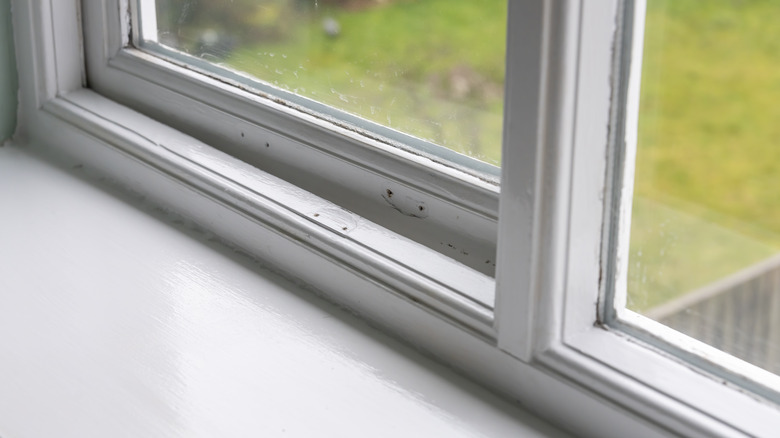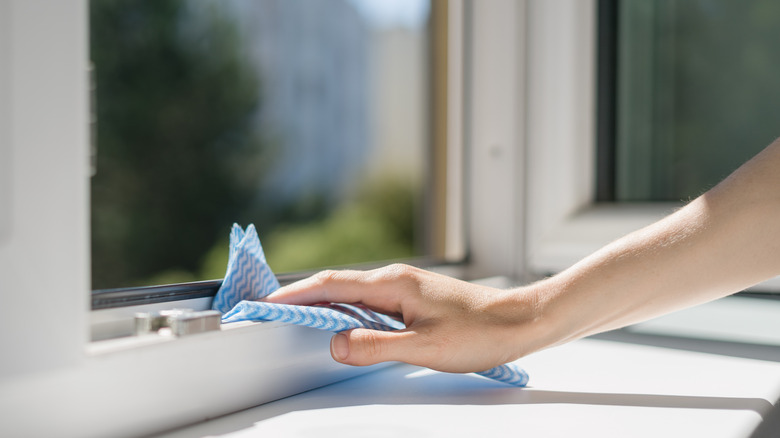How To Remove Window Sill Mold And Prevent It From Coming Back
It's common for mold to develop on a window sill, thanks partly to the condensation and warm air often found in this area. Yet, it can cause health risks if left to grow. If you spot it, early cleanup can help to minimize those risks, and it's typically not difficult to do using either white vinegar or bleach and a bit of scrubbing. The key here is to be thorough in removing all the mold spores without encouraging them to enter the air (you don't want them to spread to other areas of the home). The right technique helps minimize the risk that you could be causing health concerns for those in your family with asthma, allergies, or other respiratory infections. Understanding the types of mold and health risks is also important for homeowners.
Once you remove the mold on the window sill, take steps to prevent it from returning, including keeping this area clean and moisture at a minimum. Even the paint type you use to refresh the look of your windows can play a role in creating a mold-free environment. More so, preventing mold growth also means protecting the window since moisture damage can lead to structural window damage and air leaks. It's worth putting in a bit of work now to clean your window sills properly to prevent this problem from worsening.
Remove mold from window sill with care
Mold is made up of tiny spores that, when disturbed, enter the air and move from one place to the next. Those spores that land in a warm, moist area are likely to flourish and grow until they are hard to clean away. Because spores can enter your respiratory system, it's wise to wear protective gear, including gloves and a face mask, to prevent breathing it in.
It's possible to use most types of detergent to clean away mold, especially those marked as mold removers, but for larger problems and more aggressive mold growth, use bleach. Create a solution of ½ cup of bleach to ½ gallon of water. Apply the bleach solution onto the surface of the mold. Allow it to sit and dry thoroughly.
If using a detergent, follow the usage instructions on that product. Then spray the mold or use a towel dampened with the cleaning mixture to wipe away as much mold as you can. Dry the surface completely with a towel once all mold is removed.
An alternative to using bleach or chemical-based cleaners is to use undiluted white vinegar on the window sill itself. Simply apply it and allow it to dry. You can also use a half-and-half solution of water and ammonia in the same way as you would bleach. Spray it on, leave it there for several hours, and then wipe it clean. Don't mix ammonia and bleach products.
Preventing window sill mold development
Once you've done the work to remove the mold, take steps to prevent it from returning. The first step is always to address the underlying cause, which for windows is often condensation buildup along the window. If the windows are broken, repair them. If the seal is missing, re-caulk the windows to block out moisture buildup. Consider using a dehumidifier during very cold or very hot months to alleviate the condensation that occurs due to the extreme temperature differences on either side of the window.
Using the right paint in this area is also a good idea. Some paints are mold-resistant, which means it has a built-in inhibitor that prevents mold from developing on the surface, killing spores as they land on it. Keeping the area clean can also help. Removing the dust and dirt that can collect on the window sills, especially if the windows are left open, helps to remove an important food source for the mold. Properly cleaning windows and window sills routinely is an easy way to reduce allergens, too.
There's one more thing to keep in mind. If the mold growth is significant or has penetrated your window's wood framing, don't wait to call a professional for help. Mold that's spread to the porous drywall nearby is also difficult to fully clean. Proper mold remediation may be necessary to protect your family's health.


